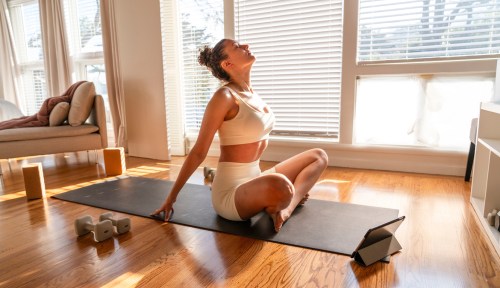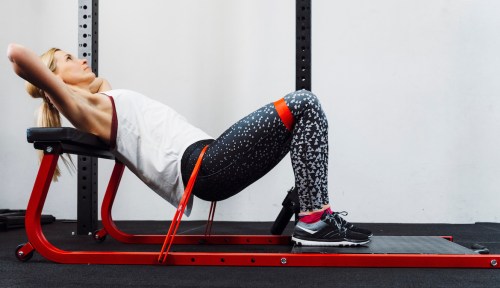Sciatica can be a pain in the butt—literally. It’s the common name for lumbar radiculopathy, a condition involving compression of the sciatic nerve, which travels from the lower back through the back of the hip and leg. Compression on this nerve can cause pain that’s either localized anywhere along this course or that radiates throughout, according to Libby Bergman, DPT, OCS, a physical therapist and orthopedic clinical specialist. This condition can make everyday movements uncomfortable, to say the least. Fortunately, there are some easy stretches for sciatica you can do at home to help relieve symptoms.
Experts in This Article
Dr. Libby Bergman, DPT, OCS, FAAOMPT, MTC, is a physical therapist and orthopedic clinical specialist at City PT.
“Sciatica is most often caused by disc herniation and age related changes in the lumbar spine, also known as the lower back,” Dr. Bergman explains. “The common symptoms occur in predictable patterns in the lower body. These can include changes in sensation or numbness, pain, and even leg strength loss in severe cases.”
Although many people who experience pain originating in the low back that radiates down the leg automatically assume it’s sciatica, Dr. Bergman says that sciatica isn’t the only condition that can lead to these symptoms. “Thus, a full physical examination by a physical therapist is crucial to get the most accurate diagnosis and treatment plan,” she advises.
Who is prone to sciatica?
While Dr. Bergman says that sciatica can affect people at any age, “in general, younger people are at higher risk of sciatica due to disc herniation, while older people are more at risk due to arthritic changes,” she explains.
Overall, men, as well as anyone with a high body mass index, obesity, diabetes, high cholesterol, people who smoke, or those with too much stress are at a higher risk for sciatica, Dr. Bergman adds. She says additional risk factors for sciatica include genetics/family history, and having occupations that require repetitive or heavy lifting, twisting, or sitting for long periods of time.
How stretching can help alleviate the symptoms of sciatica
In most cases, treatment for sciatica is multifaceted, and depends on your specific symptoms, history, and cause. Stretching is often a helpful component of treatment for many people, as is strength training. It’s a good idea to work with a physical therapist—at least initially—to help ensure you are properly diagnosed and have a personalized treatment program that addresses whatever is causing the irritability of the sciatic nerve.
“In general, the goal of stretching is to decrease pressure on the nerve root and relax surrounding tissues that are contributing to the pain due to spasms and blood flow constriction,” says Dr. Bergman. “However, stretching too aggressively or too early in the course of the condition may aggravate sensitized neural tissue.”
5 stretches for sciatica
1. Figure 4 stretch
This stretch relieves sciatica since this nerve goes right through the center of the piriformis, a muscle in your butt located near the top of the hip joint, Dr. Bergman says. “This muscle often goes into a holding state, as a knot or spasm, in the presence of nerve inflammation,” she explains. “Regular, non-painful stretching can help relieve the muscular pressure on the sciatic nerve, particularly in later stages of recovery.” She says to perform this stretch on both sides—even the non-painful side—if you have time.
How to: Lie on your back with both knees bent and feet flat on the floor. Cross the ankle of the painful leg over the thigh of the opposite leg, just above the knee. Gently press down on the inside of the elevated knee until you feel a stretch in the front or side of your hip or back. Alternatively, try pulling the elevated knee toward the opposite shoulder from this position instead of pushing down. Dr. Bergman says that depending on which muscles are specifically involved, one position may feel better than the other, and you can try both and choose the one that feels best. Hold for 20 to 30 seconds. Repeat several times per day.
2. Cat/cow
According to Dr. Bergman, this gentle stretch mobilizes the spine and can reduce sciatic pain. “Motion is lotion! Gently moving the spine in an ‘unweighted’ position will help to relax any tight muscles,” she notes. “In doing so, this will encourage better circulation to affected areas to reduce inflammation and promote healing. Overall, it’ll help you feel more confident in your back’s ability to move pain free.”
How to: Get down on your hands and knees with your hands under your shoulders and knees under your hips. Inhale as you move into the “cat” position by gently rounding your back toward the ceiling, thinking about bringing your nose to your belt buckle. Hold for a few seconds, then exhale as you move into the “cow” position by lowering your belly toward the floor, arching your back and looking forward. Dr. Bergman says to think about tipping your pelvis forward or sticking your butt out as you do this. Repeat 10 to 15 times through a pain-free range of motion several times per day.
3. Sciatic nerve glide
Dr. Bergman says that in some cases of sciatica, local inflammation of the nerve can lead to an area of restriction that exacerbates symptoms, particularly as symptoms start to subside. “This exercise is intended to help the nerve restore its ability to glide through the surrounding tissue, like floss glides through your teeth,” she says, adding that this exercise works best in later stages of recovery and is not advised when it causes pain during the stretch.
How to: Lie on your back with the hip of the painful leg flexed to 90 degrees, so that your kneecap is pointing to the ceiling, and shin is parallel to the floor. Hold onto this leg at the back of your thigh. Flex your foot and hold this position of the ankle throughout the exercise. Slowly straighten your knee until you feel an easy stretch down the back of the leg. If your symptoms are acute or this causes pain, DO NOT push into or through the pain. Repeat 10 to 15 times through a pain-free range of motion several times per day. Repeat 10 to 15 times through a pain-free range of motion several times per day.
4. Prone press-ups
Dr. Bergman says this stretch is best for people experiencing a disc herniation as the cause of their sciatic pain. “It can help desensitize the nerve to reduce experienced symptoms,” she explains. “When you do this [stretch] consistently over several days or weeks, the pain you experience in your leg should ‘centralize,’ or move up toward the buttocks. This is a sign of improvement in your condition!”
How to: Lie on your stomach with your hands flat under your shoulders. Press up gently through your hands only, allowing your back to arch away from the bed or floor, leaving your legs and pelvis pressing into the surface beneath you. This may cause a sensation or stretch down the back of the affected leg. Hold for five seconds, then slowly lower back down. Repeat 10 times.
5. Double knees to chest stretch
According to Dr. Bergman, for people with arthritic sciatic pain, this gentle flexed position of the spine feels good on stiff joints. “This stretch provides a temporary increase in space for the nerve, giving it time to heal,” she adds. However, she says this exercise is not recommended for anyone with a suspected disc herniation because it can aggravate symptoms.
How to: Lie on your back and gently hug both of your knees to your chest. Hold this position with some deep breaths for up to 30 seconds. Lower your legs back down. Repeat three times and throughout the day for best results.
Stretching for sciatica best practices
Stretching can definitely be an integral component of an effective treatment plan for sciatica. Dr. Bergman highly recommends seeing a physical therapist to help you find the cause and get you moving again as productively as possible.
Either way, always use pain as your guide. Listen to your body, and if a stretch seems to be aggrevating your pain, stop. Be gentle on yourself. However, movement can be medicine so don’t be afraid to try some of these stretches for sciatica and see if they help you.
Sign Up for Our Daily Newsletter
Get all the latest in wellness, trends, food, fitness, beauty, and more delivered right to your inbox.
Got it, you've been added to our email list.











